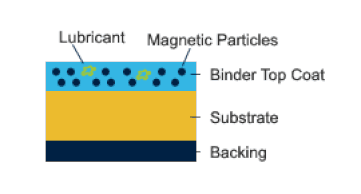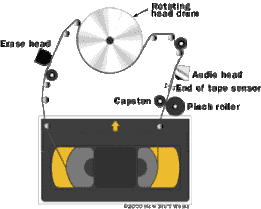The Importance of Digital Transfer
Why Video Tapes Decay
Video tapes formats like VHS, SVHS, VHS-C, and Hi 8 are made up of three layers: the binder, substrate, and backing. The binder layer comes into direct contact with the heads of your vcr and produces the signal we see on out tv. It has a lubricant to prevent damage when it is playing in the vcr as it moves across the heads. The signal on the tape is recorded on a magnetic oxide. The substrate and backing are there for strength. Magnetic tape can deteriorate in many ways. The metal particles can lose their charge which is called "remanence decay". This results in noticeable loss of color and detail.
Another is "demagnetization" which can come from storing video tapes around your tv, stereo or any electronic equipment, and could result in a partially or completely erased tape. Binder loss or binder breakdown can make videotapes a sticky unplayable mess, and substrate and backing can stretch from repeated rewinding and fast forwarding causing tracking and playback issues.
So How Long Will My Videos Last?
There has been a considerable amount of research done about longevity specifically on a wide range of video tapes by the National Media Laboratory,
Jet Propulsion Labs at Cal Tech, the National Bureau of Standards, The Advanced Development Corporation, and manufacturers Sony and Fuji.
The results concluded that the issue is how you store your tapes. It appears that most tapes will have a 10 to 20% loss of signal from remanence decay after 10 to 25 years. This can increase if magnetic tape is stored improperly.
So how can you protect them.
Keep them cool and dry located in the same temperature and humidity that you like. Keep them out of the basement or attic and free from dust and dampness and they will reward you with wonderful memories. And of course...get them digitized and archived to protect them for the next generation.
Do it today before it's too late.
Why Video Tapes Decay
Video tapes formats like VHS, SVHS, VHS-C, and Hi 8 are made up of three layers: the binder, substrate, and backing. The binder layer comes into direct contact with the heads of your vcr and produces the signal we see on out tv. It has a lubricant to prevent damage when it is playing in the vcr as it moves across the heads. The signal on the tape is recorded on a magnetic oxide. The substrate and backing are there for strength. Magnetic tape can deteriorate in many ways. The metal particles can lose their charge which is called "remanence decay". This results in noticeable loss of color and detail.
Another is "demagnetization" which can come from storing video tapes around your tv, stereo or any electronic equipment, and could result in a partially or completely erased tape. Binder loss or binder breakdown can make videotapes a sticky unplayable mess, and substrate and backing can stretch from repeated rewinding and fast forwarding causing tracking and playback issues.
So How Long Will My Videos Last?
There has been a considerable amount of research done about longevity specifically on a wide range of video tapes by the National Media Laboratory,
Jet Propulsion Labs at Cal Tech, the National Bureau of Standards, The Advanced Development Corporation, and manufacturers Sony and Fuji.
The results concluded that the issue is how you store your tapes. It appears that most tapes will have a 10 to 20% loss of signal from remanence decay after 10 to 25 years. This can increase if magnetic tape is stored improperly.
So how can you protect them.
Keep them cool and dry located in the same temperature and humidity that you like. Keep them out of the basement or attic and free from dust and dampness and they will reward you with wonderful memories. And of course...get them digitized and archived to protect them for the next generation.
Do it today before it's too late.
Parking in SONO is from 8am-9pm Mon-Sat.
FREE after 9pm and on Sundays and Holidays.
FREE after 9pm and on Sundays and Holidays.
HoursM-TH: 10am-5pm
|
Telephone203-854-9965
|
|

